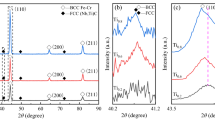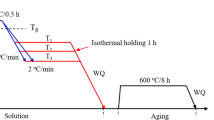Abstract
The effects of cooling rate on the stress corrosion cracking (SCC) susceptibility of β-processed Ti–6Al–4V (Ti64) alloy, including BA/S specimen with furnace cooling and BQ/S specimen with water quenching, were investigated in 0.6M NaCl solution under various applied potentials using a slow strain rate test technique. It was found that the SCC susceptibility of β-processed Ti64 alloy in aqueous NaCl solution decreased with fast cooling rate, which was particularly substantial under an anodic applied potential. The micrographic and fractographic analyses suggested that the enhancement with fast cooling rate was related to the random orientation of acicular α platelets in BQ/S specimen. Based on the experimental results, the effect of cooling rate on the SCC behavior of β-processed Ti64 alloy in aqueous NaCl solution was discussed.











Similar content being viewed by others
References
M.J. Donachie, Titanium: A Technical Guide, 2nd edn. (ASM International, Ohio, 2000), p. 5
H. Chandler, Heat Treater’s Guide: Practices and Procedures for Nonferrous Alloys (ASM International, Ohio, 1996), p. 459
R. Wanhill, S. Barter, Fatigue of Beta Processed and Beta Heat-treated Titanium Alloys (Springer, Berlin, 2011), p. 1
S.L. Semiatin, V. Seetharaman, I. Weiss, JOM 39, 33 (1997)
G. Welsch, R. Boyer, E.W. Collings, Materials Properties Handbook: Titanium Alloys (ASM International, Ohio, 1993), p. 484
D.H. Jeong, Y.N. Kwon, M. Goto, S.S. Kim, Int. J. Mech. Mater. Eng. 12–1, 1 (2017)
D.H. Jeong, H.K. Sung, Y.N. Kwon, S.S. Kim, Met. Mater. Int. 22–4, 594 (2016)
D.H. Jeong, H.K. Sung, Y.N. Kwon, S.S. Kim, Met. Mater. Int. 22–5, 747 (2016)
R.P. Gangloff, B.P. Somerday, Gaseous Hydrogen Embrittlement of Materials in Energy Technologies: The Problem, its Characterisation and Effects on Particular Alloy Classe (Elsevier, Amsterdam, 2012), p. 970
G.R. Yoder, L.A. Cooley, T.W. Crooker, Metall. Mater. Trans. A 9A, 1413 (1978)
F.C. Campbell Jr., Manufacturing Technology for Aerospace Structural Materials (Elsevier, Amsterdam, 2011), p. 152
G.R. Yoder, L.A. Cooley, T.W. Crooker, A micromechanistic interpretation of cyclic crack-growth behavior in a beta-annealed Ti–6Al–4V alloy, No. NRL-8048 (Naval Research Lab, Washington, 1976)
W.G. Seo, D.H. Jeong, H.K. Sung, Y.N. Kwon, S.S. Kim, Met. Mater. Int. 23, 648 (2017)
R. Pederson, Microstructure and Phase Transformation of Ti–6Al–4V (Luleå University of technology, Luleå, 2002)
R. Pederson, The Microstructures of Ti–6A1–4V and Ti–6Al–2Sn–4Zr–6Mo and their Relationship to Processing and Properties (Luleå University of technology, Luleå, 2004)
G. Lütjering, J.C. Williams, Titanium (Springer, Berlin, 2013), p. 218
M. Peters, J. Hemptenmacher, J. Kumpfert, C. Leyens, Structure and properties of titanium and titanium alloys, in Titanium and Titanium Alloys, vol. 1, ed. by C. Leyens, M. Peters (Wiley, New Jersey, 1982), p. 1
M.J. Donachiel Jr., Heat Treating Titanium and Its Alloys. Heat Treating Progress (ASM International, Ohio, 1993), p. 49
M.J. Donachie, Titanium: A Technical Guide, 2nd edn. (ASM International, Ohio, 2000), p. 58
X.G. Zhang, J. Vereecken, Corrosion 46(2), 136 (1990)
G.V. Voort, Metallographic Preparation of Titanium and its alloys (Buehler, Illinois, 2015), p. 2
D.H. Jeong, J.H. Park, S.J. Ahn, H.K. Sung, Y.N. Kwon, S.S. Kim, Met. Mater. Int. 24–1, 101 (2017)
ASTM Standard G129, Standard Practice for Slow Strain Rate Testing to Evaluate the Susceptibility of Metallic Materials to Environmentally Assisted Cracking (Annual book of ASTM standards, 03.02, West Conshohocken, 2000)
Y.S. Yoon, H.Y. Ha, T.H. Lee, S.S. Kim, Corros. Sci. 80, 28 (2014)
Y.S. Yoon, H.Y. Ha, T.H. Lee, S.S. Kim, Corros. Sci. 88, 337 (2013)
H.Y. Ha, W.G. Seo, J.Y. Park, T.H. Lee, S.S. Kim, Mater. Charact. 119, 200 (2016)
D.H. Jeong, W.J. Jung, Y.J. Kim, M. Goto, S.S. Kim, Met. Mater. Int. 21(5), 785 (2017)
D.B. Dawson, R.M. Pelloux, Metall. Mater. Trans. A 5, 723 (1974)
R.P. Wei, Fracture Mechanics: Integration of Mechanics, Materials Science and Chemistry (Cambridge University Press, Cambridge, 2010), p. 173
T.F. Broderick, A.G. Jackson, H. Jones, F.H. Froes, Metall. Mater. Trans. A 16A, 1985 (1951)
M.R. Louthan, J.A. Donovan, D.E. Rawl, Corrosion 29(3), 108 (1973)
E. Tal-Gutelmacher, D. Eliezer, JOM 57, 46 (2005)
H.G. Nelson, D.P. Williams, J.E. Stein, Metall. Mater. Trans. A 3, 469 (1972)
Acknowledgements
This work has been supported by the Engineering Research Center (ERC) Program through the National Research Foundation of Korea (NRF) funded by the Ministry of Education, Science and Technology (2011-0030801), and the National Research Foundation of Korea (NRF) grant funded by the Korean Government (NRF-2016H1D2A2916874). This work was also supported by the Industrial Technology Innovation Program (10050561, Forming, Post-treatment and Assembly Manufacturing Technology for Nozzle Fairing of 17,700 lbs Supersonic Engine) funded by the Ministry of Trade, industry and Energy(MI, Korea), and the Fundamental Research Program of the Korea Institute of Materials Science (KIMS).
Author information
Authors and Affiliations
Corresponding author
Rights and permissions
About this article
Cite this article
Ahn, S., Park, J., Jeong, D. et al. Effect of Cooling Rate on SCC Susceptibility of β-Processed Ti–6Al–4V Alloy in 0.6M NaCl Solution. Met. Mater. Int. 24, 327–336 (2018). https://doi.org/10.1007/s12540-018-0031-9
Received:
Accepted:
Published:
Issue Date:
DOI: https://doi.org/10.1007/s12540-018-0031-9




